Related Research Articles

Barbecue or barbeque is a term used with significant regional and national variations to describe various cooking methods that employ live fire and smoke to cook the food. The term is also generally applied to the devices associated with those methods, the broader cuisines that these methods produce, and the meals or gatherings at which this style of food is cooked and served. The cooking methods associated with barbecuing vary significantly but most involve outdoor and indoor cooking.

Kebab, kabob, kebap, kebob, or kabab (Kashmir) is a variety of roasted meat dishes that originated in the Middle East. Many variants of kebab are popular around the world, including the skewered shish kebab or the doner kebab with bread.
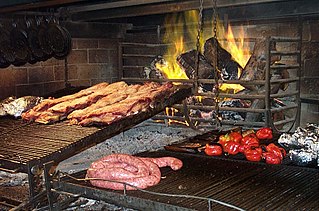
Asado is the technique and the social event of having or attending a barbecue in various South American countries: especially Argentina, Brazil, Chile, Paraguay, Peru, and Uruguay where it is also a traditional event. An asado usually consists of beef, pork, chicken, chorizo, and morcilla; all of which are cooked using an open fire or a grill, called a parrilla. Usually, red wine and side dishes such as salads accompany the main meats, which are prepared by a designated cook called the asador or parrillero.
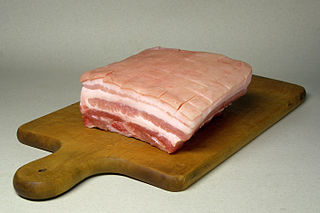
Pork belly or belly pork is a boneless, fatty cut of pork from the belly of a pig. Pork belly is particularly popular in American, Swedish, Danish, Norwegian, Polish, Hispanic, Filipino, Chinese, Vietnamese, and Thai cuisine.

Sosatie is a traditional South African dish of meat cooked on skewers. The term derives from sate and saus. It is of Cape Malay origin, used in Afrikaans—the primary language of the Cape Malays, and the word has gained greater circulation in South Africa. Marinated, cubed meat is skewered and cooked by braaing (barbecued) shish kebab style. Sosatie recipes vary, but commonly the ingredients can include cubes of lamb, beef, chicken, dried apricots, red onions and mixed peppers.
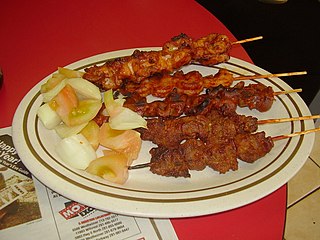
“Tsire” commonly known as suya is a traditional smoked spiced meat skewer which originates from Nigeria, and is a popular food item across West Africa. Suya is a large part of Hausa culture and food and is traditionally prepared and made by Hausa men, thus called 'Mai tsire'. While suya is the more widely recognized name in many areas of Nigeria, the Hausa community still predominantly uses the original name, tsire. Suya is generally made with skewered beef, ram, or chicken. Organ meats such as kidney, liver and tripe are also used. The thinly sliced meat is marinated in various spices, which include traditional Hausa dehydrated peanut cookie called 'kwulikwuli', salt, vegetable oil and other spices and flavorings, and then barbecued. There are many variation of Suya in traditional Hausa cooking, but the most popular being suya. Suya is traditionally served with an extra helpings of mixed dried pepper, traditional hausa spices, and sliced onions. It is also traditionally served in Hausa culture with a side serving of Hausa Masa. Halal meat preparation methods are normally used, especially in the northern parts of Nigeria where it originates as is customary with traditional Hausa foods, where the suspicion of nonconformity to Muslim dietary prohibitions in Suya preparation has been known to cause riots. A dried version of Suya is called Kilishi. It can be eaten with Masa, Kosai, Garri or Ogi.
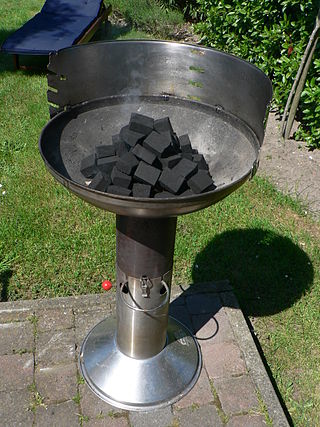
Barbecue varies by the type of meat, sauce, rub, or other flavorings used, the point in barbecuing at which they are added, the role smoke plays, the equipment and fuel used, cooking temperature, and cooking time.

Ribs of pork, beef, lamb, and venison are a cut of meat. The term ribs usually refers to the less meaty part of the chops, often cooked as a slab. Ribs of bison, goat, ostrich, crocodile, alligator, llama, alpaca, beefalo, African buffalo, water buffalo, kangaroo, and other animals are also consumed in various parts of the world.
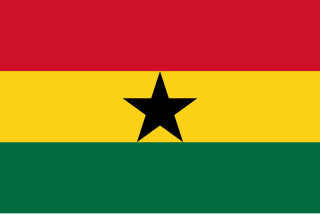
Ghanaian cuisine refers to the meals of the Ghanaian people. The main dishes of Ghana are centered around starchy staple foods, accompanied by either a sauce or soup as well as a source of protein. The primary ingredients for the vast majority of soups and stews are tomatoes, hot peppers, and onions. As a result of these main ingredients, most Ghanaian jollof rice, soups, and stews appear red or orange.

The cuisine of Senegal is a West African cuisine that derives from the nation's many ethnic groups, the largest being the Wolof and is French influenced. Islam, which first embraced the region in the 11th century, also plays a role in the cuisine. Senegal was a colony of France until 1960. From the time of its colonization, emigrants have brought Senegalese cuisine to many other regions.
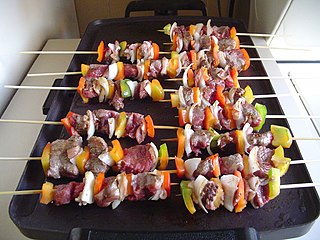
Many regional cuisines feature a mixed grill, a dish consisting of an assortment of grilled meats.

Mongolian barbecue is a stir-fried dish that was developed in Taiwan during the 1950s. Despite its name, the dish is not Mongolian and is only loosely related to barbecue.

West African cuisine encompasses a diverse range of foods that are split between its 16 countries. In West Africa, many families grow and raise their own food, and within each there is a division of labor. Indigenous foods consist of a number of plant species and animals, and are important to those whose lifestyle depends on farming and hunting.

Nigerian cuisine consists of dishes or food items from the hundreds of Native African ethnic groups that comprises Nigeria. Like other West African cuisines, it uses spices and herbs with palm oil or groundnut oil to create deeply flavored sauces and soups.

Méchoui or Meshwi is a whole sheep or lamb spit-roasted on a barbecue in Maghrebi cuisine. The word comes from the Arabic word šawā. This dish is very popular in North Africa.
Barbadian cuisine, also called Bajan cuisine, is a mixture of African, Portuguese, Indian, Irish, Creole, Indigenous and British background. A typical meal consists of a main dish of meat or fish, normally marinated with a mixture of herbs and spices, hot side dishes, and one or more salads. The meal is usually served with one or more sauces.

Kyinkyinga or cincinga, is a grilled meat skewer or kebab that is common and popular in West Africa and is related to the Suya kebab. Kyinkyinga is a Ghanaian Hausa dish popularised by traders in the Zango areas of town and cities, and has since becoming popular among other Ghanaians. It is hence very similar to or synonymous with the suya kebab in Nigeria and Niger, also known as suya, tsinga, cinga, cicinga, cincinga, tsire agashi, cacanga or tankora in the Hausa language.
References
- ↑ "Dibi". Encyclopædia Britannica . Retrieved 2021-06-29.
- ↑ "Bantyii Dibiterie". Atlas Obscura . Retrieved 2021-11-03.
- ↑ "I Call Dibi!". Southern Foodways Alliance . Retrieved 2021-11-04.